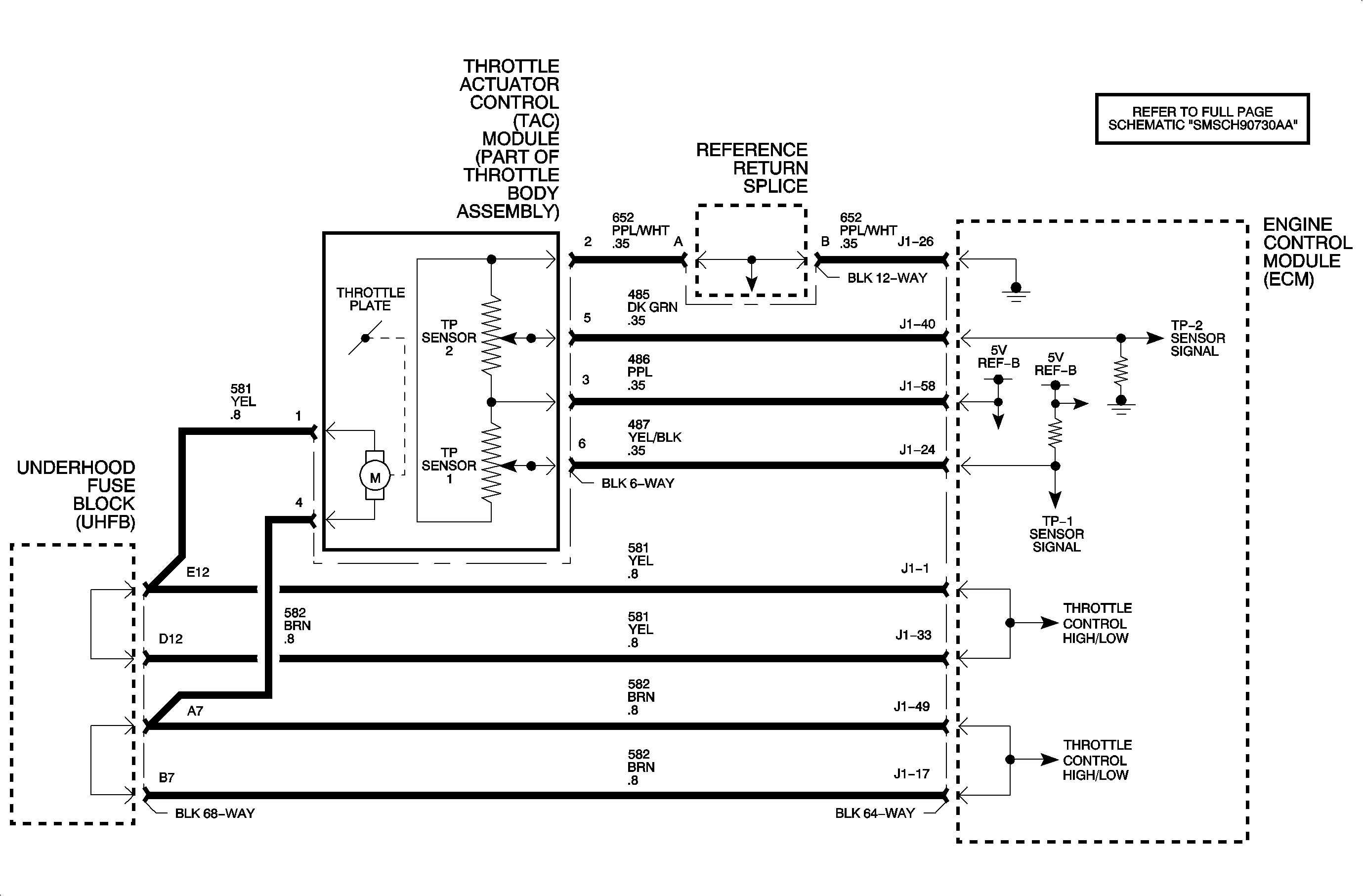
Circuit Description
The throttle actuator control (TAC) module contains a direct current actuator
motor controlled by the engine control module (ECM) used to move the throttle plate,
in either direction, and 2 throttle position (TP) sensors to determine throttle
plate position. The throttle plate is held at a 7 percent rest position to
a mechanical stop by a constant force return spring. This spring will hold the throttle
plate to the stop when there is no current flowing to the actuator motor. There is
another return spring, which creates constant force on the throttle plate only when
the throttle plate is moved towards the full closed position. The ECM will monitor
both the actuator motor and TP sensors for circuit faults, as well as check to make
sure both springs can return the throttle to the 7 percent position no matter
where the throttle plate remains.
The ECM will go through a throttle relearn procedure 29 seconds after
the ignition is turned ON with the engine OFF as long as certain conditions have been
met. During this learn procedure, the ECM will move the throttle from the rest to
full closed position, then to around 14 percent. During this period, the TP
sensors lower limits, rest position of the TP sensors, the actuator motor force to
overcome both spring pressures as well as the return rates of both springs are learned.
If any of these parameters are out of range, a DTC will be set. DTC P1526 will
set if the throttle has not been learned after the ECM has been reprogrammed, OR the
learned rest position TP values do not match the stored learned values within a certain
range.
Conditions for Setting the DTC
DTC P1526 will set if the throttle has not been learned after the ECM
has been reprogrammed.
The learned lower rest position TP values are too far out of range from the
stored learned values when:
| • | During a once per key-up close throttle test |
| • | The engine speed is less than 250 RPM. |
| • | The vehicle speed is 0 mph. |
| • | The ECT is between 5-100°C (41-212°F). |
| • | The IAT is greater than 5°C (41°F). |
| • | The accelerator pedal angle is less than 15 percent. |
| • | The battery voltage is greater than 10 volts. |
DTC P1526 diagnostic runs during a key-up closed throttle test when the
above conditions have been met.
DTC P1526 is a type D DTC.
The malfunction indicator lamp (MIL) will illuminate after 5 seconds.
Diagnostic Aids
Important: If a TP sensor 1 or 2 DTC is also set, diagnose that DTC first. Then
if DTC P1516 is also set, diagnose that DTC next. Then if DTC P1510
is also set, diagnose that DTC next.
Important: DTC P1526 must have a key cycle to clear. Therefore, it may take 2 times
to clear the DTC from the ECM memory.
If DTC P1526 is set, the ECM will default to 1 of the 2 limp home
modes, random injector disable with engine speed limited to 1,800 RPM. The
REDUCED POWER telltale will be illuminated and the ECM will remain in this condition
for the entire ignition cycle even if the fault is corrected.
The throttle body relearn procedure should be performed anytime a throttle body
has been replaced or an ECM has been replaced or reprogrammed.
Throttle Body Relearn Procedure
| • | The ignition is OFF for 10 seconds. |
| • | The ignition is ON with the engine OFF. |
| • | Ensure these engine operating parameters are met before proceeding: |
| - | The ECT is between 5-100°C (41-212°F). |
| - | The IAT is greater than 5°C (41°F). |
| - | The battery voltage is above 10 volts. |
| - | The accelerator pedal angle less then 14 percent. |
| • | Leave the ignition ON for 1 minute with the engine OFF. |
The ECM will start at 29 seconds to cycle the throttle plate from the
rest position to full closed, then from the full closed position to around 10 percent.
This will take about 3 seconds. The ECM will then return the throttle to the
rest position. During this throttle plate cycle, the ECM will have learned the lower
and rest position TP sensor values, actuator motor torque to overcome spring pressure,
as well as both spring return rates.

